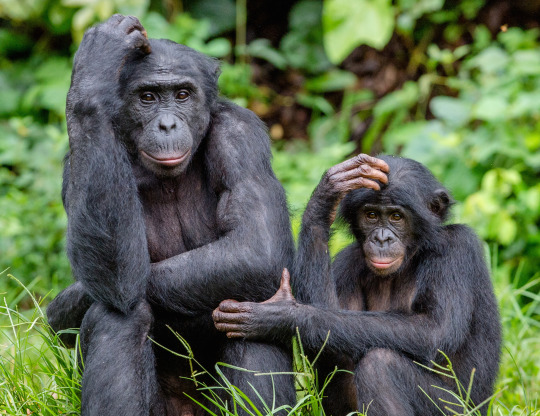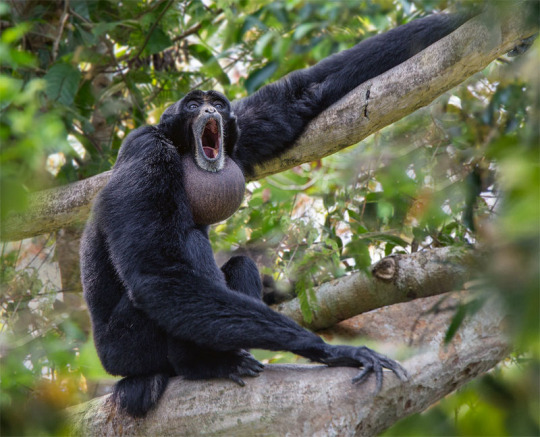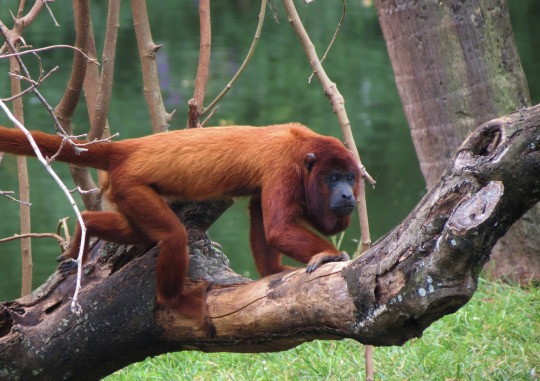#primate bracket round 2
Text
🦍Primate tournament masterpost🦧

(A full list of primates enlisted in the tournament can be found here)
The final round has begun! Scroll down on my account to vote!
Current matchups:

#primate bracket#tournament#tumblr tournament#poll#polls#extinct primates#biology#animals#zoology#primate bracket round 1 part 1#primate bracket round 1 part 2#primate bracket round 2#primate bracket round 3#primate bracket round 4#primate bracket semifinals
33 notes
·
View notes
Text
Round 2, match 4: skrunkly little guys
Aye-aye (Daubentonia madagascariensis)

A lemur you will likely all have heard of! They live in the canopy of tropical forests, weaving little nests to sleep in during the day. At night, they come out to feed- sometimes on fruits and seeds, but they’re most well known for their unique way of hunting grubs. By tapping their spidery fingers on wood, they can hear insects hiding within. When they find one, they chew a hole through the wood with their incisor teeth, before reaching in with their thin middle finger to fish out the grub. Yum?
Pygmy tarsier (Tarsius pumilus)

Tarsiers are tiny, nocturnal primates found in Southeast Asia. They may be cute, with eyes almost as large as their brains, but they are actually the most carnivorous primates. They hunt mostly small arthropods, like insects and arachnids.
The pygmy tarsier is perhaps the most unusual tarsier species. They are tiny, weighing less than two ounces, and they live in the highland forests of Sulawesi. They are also incredibly elusive- they are rare, and their calls are probably outside the range of human hearing. Because of this, they were not seen for eighty years, long assumed extinct since the 1920s. It was not until 2008 that a group of scientists were able to observe living members of this species, confirming they were still alive.
21 notes
·
View notes
Text
Round 2, match 15: African apes
Western lowland gorilla (Gorilla gorilla gorilla)

These huge, powerful apes are found in the lowland tropical forests of Western Africa. They are highly sexually dimorphic, and dominant males are often called silverbacks for their light grey backs. They eat leaves, fruits, roots, tree bark, and occasionally small animals. They are also known to use tools, and famously Koko the gorilla was apparently able to communicate using sign language, although the extent to which she understood has been questioned by many scientists. I chose to use this subspecies because their full scientific name (Gorilla gorilla gorilla) is funny to me.
Bonobo (Pan paniscus)

Once known as the pygmy chimpanzee, the bonobo is now recognised as a separate species. They live in tropical forests south of the Congo River, and eat fruit, leaves, honey, and small animals like insects and mammals. They are very social and less violent than chimpanzees. They’re also really horny, like all the time. They’re the only non-human species known to engage in tongue kissing and face-to-face sex, because of course they are. And as expected from a species whose sex lives have been studied as much as they have, both male-male and female-female relations have been documented.
20 notes
·
View notes
Text
Round 2, match 11: miscellaneous monkeys
Japanese macaque (Macaca fuscata)

Beaten only by humans for the title of the furthest-north primate, this monkey lives in a huge range of climates on the islands of Japan, including snowy and mountainous regions. They are famous for their habit of spending time in hot springs to escape the cold. They are also rather intelligent, one group of macaques inventing the idea to wash their food before consumption. They eat a variety of foods, including leaves, fruits, bark, roots, insects, fish, soil, and fungus. Finally, the Japanese macaque is another species of monkey in which homosexuality has been documented; it has even been proposed that most female members of this species are bisexual!
Mandrill (Mandrillus sphinx)

These extremely colourful primates are mostly terrestrial, but they live in the tropical rainforests of west Africa and still sometimes climb trees. They eat mostly leaves and seeds, but also many types of small animals. They have even been recorded hunting small antelope! Mandrills live together in groups called hordes, which can be made up of hundreds of members.
17 notes
·
View notes
Text
Round 2, match 10: Asian monkeys
Golden snub-nosed monkey (Rhinopithecus roxellana)

This brightly-coloured, highly sexually dimorphic monkey lives in the treetops of cold, forested mountains. These mountains, found in central China, are more than 4900 feet (1500m) high, and many parts are covered in snow. The monkeys eat mostly lichen, but also leaves and fruits during the warmer months.
Red-shanked douc (Pygathrix nemaeus)

This fabulous-looking species is found in tropical, sometimes mountainous forests of Southeast Asia. They eat mostly leaves, and have a multi-chambered stomach which allows them to ferment their food, like a ruminant!
16 notes
·
View notes
Text
Round 2, match 14: Asian apes
Siamang (symphalangus syndactylus)

The largest species of gibbon, the siamang is notable for a huge throat pouch it can inflate to produce booming calls. Like other gibbons, siamang couples sing together in the morning to broadcast their bond. They are found on the island of Sumatra and the Malay peninsula, eating fruits, leaves, and flowers.
Bornean orangutan (Pongo pygmaeus)

These large tree-dwelling apes are found only on the island of Borneo. They are highly sexually dimorphic, with dominant males growing large cheek flanges. They eat fruits, leaves, flowers, bark, honey, small animals like insects, spider webs, fungus, and soil. They build complex nests to sleep in, and have been observed using leafy makeshift ‘umbrellas’, sticks to obtain foods like ants, and leaves to hold spiny fruits.
13 notes
·
View notes
Text
Round 2, match 16: our close relatives
†Australopithecus (Australopithecus afarensis)

Artwork credit: Kepyle2055
Over the last few million years, a huge variety of hominins (human relatives) have arisen, only to go extinct and leave us all alone. A. afarensis lived from about 3.9-2.9 million years ago, and were short bipedal apes which were good at walking and might have been able to climb. They appear to have been highly adaptable, occupying a variety of environments- forest, savanna, etc- in east Africa. They likely ate a variety of foods, including grass, leaves, seeds, fruits, roots, insects, and small vertebrates.
†Neanderthal (Homo neanderthalensis)

Artwork credit: Tom Björklund
Our closest relatives, the Neanderthals, lived in Eurasia up until about 40,000 years ago. They were shorter and bulkier than us, with larger skulls, and genetic testing reveals they had a variety of skin colours but generally had lighter brown or red hair. They were prolific hunters of megafauna, but probably foraged for other food sources as well. They used stone tools, cooked their food, probably made clothing, and some seem to have used boats to reach Mediterranean islands. The fact that Neanderthals are often found with healed injuries reveals that they had a good knowledge of medicinal herbs and how to treat injuries, and that they cared for the sick and injured members of their society. Their extinction coincides with the arrival of our species into Europe, and many prehistoric relationships between humans and Neanderthals have led to the presence of Neanderthal DNA in most modern humans.
13 notes
·
View notes
Text
Round 2, match 5: tiny little monkeys
Wied’s marmoset (Callithrix kuhlii)

This little monkey is found in tropical Brazilian forests, with an omnivorous diet mostly composed of tree sap. But marmosets are weirder than they seem on the surface. This group of small monkeys usually give birth to non-identical twins, and these twins will often swap cells while in the womb. So many marmosets are chimeras, made of more than one genetic code! Even weirder is that these swapped cells can sometimes be gametes; sperm or egg cells. So, a chimeric marmoset can give birth to a child using an egg that came from her twin!
Bearded emperor tamarin (Saguinus imperator subgrisescens)

This tiny, tiny tamarin is found in the wet forests where Brazil and Peru border each other. They eat fruit, flowers, fungus, and tree sap- but they’re apparently too lazy to dig their own holes in trees, so they wait for a different species to do it for them. And, of course, they have those magnificent moustaches.
15 notes
·
View notes
Text
Round 2, match 7: monkeys
Atlantic titi monkey (Callicebus personatus)

These masked monkeys are found in forests near the Atlantic coast of Brazil. They eat virtually anything available to them, but mostly fruits and seeds. But for an as yet unknown reason, they will occasionally eat soil. When they do this, they usually sit atop ant or termite mounds to be further off the ground.
White-faced saki (Pithecia pithecia)

This is a highly omnivorous saki found in several countries in the north of South America. They are very active and a group of sakis will sometimes mob predators to scare them away. They are highly sexually dimorphic, females being smaller and grey, while males are large and sport the species’ characteristic white face.
12 notes
·
View notes
Text
Round 2, match 2: more basal primates
Bengal slow loris (Nycticebus bengalensis)

Slow lorises are nocturnal inhabitants of Southeast Asian forests. They’re also the only venomous primates, and one of the only groups of venomous mammals. They produce certain chemicals in a gland near their armpit, and others in their saliva; when mixed, either by licking their armpit or wiping their gland juice on their teeth, the chemicals combine to produce a noxious toxin.
This species is the largest of the slow lorises. The chemicals produced from their armpit gland may not just be for defence, but also for communicating information with other lorises via scent. It eats small animals, mostly insects, as well as fruit and tree sap.
Senegal bushbaby (Galago senegalensis)

Bushbabies are fast, agile little primates found in the dry forest and savanna of central Africa. They have large, flexible ears which, like bats, help them hunt insects in the dark of night. They can make incredible leaps from tree to tree where the woodland becomes sparse.
11 notes
·
View notes
Text
Round 2, match 13: gibbons
Gibbons are known as the lesser apes, and like great apes lack an external tail. They are experts at brachiation- swinging from branch to branch- and are today all found in Southeast Asia.
Lar gibbon (Hylobates lar)

These gibbons are found in the canopy of tropical forests from Myanmar in the north to Indonesia in the south. They eat fruit, leaves, flowers, and insects. Unusually, they come in a variety of colours, from dark brown to light tan. Lar gibbons are known for their haunting calls, duets performed between pairs at sunrise.
Northern white-cheeked gibbon (Nomascus leucogenys)

A sexually dimorphic gibbon species, the males have black fur with white cheek tufts and a small throat sac, while females have cream fur and are slightly smaller. Males use their throat sac to produce loud calls, and monogamous pairs sing together at dawn. This species is found in Vietnam and Laos, and eats fruits, leaves, and small animals.
13 notes
·
View notes
Text
Round 2, match 1: really basal primates
Calabar angwantibo (Arctocebus calabarensis)

This relative of the pottos and lorises lives in the tropical rainforest of Western Africa. It eats insects, usually caterpillars, as well as some occasional vegetation. It is also slow-moving and nocturnal- the angwantibo and its relatives are unusual primates in many ways, more like nocturnal sloths than monkeys. The calabar angwantibo also has a nictitating membrane, because… why the hell not?
West African potto (Perodicticus potto)

This is another really weird primate. It’s found in tropical forests in Western Africa, and eats mostly fruit with a side of insects and tree sap, coming out only at night. It also has a vestigial index finger… and spiky outgrowths on its neck vertebrae which it uses to defend itself. Oh, and its bite can cause inflammation. It’s like the platypus of primates!
11 notes
·
View notes
Text
Round 2, match 3: lemurs
Verreaux’s sifaka (Propithecus verreauxi)

These lemurs are very specialised for living in trees, eating mostly leaves and being capable of leaping ten metres from tree to tree. They also live in a variety of wet or dry forest habitats. Sifakas are so specialised for climbing they can’t walk on all fours like a ring-tailed lemur, nor can they stride bipedally like humans; instead, they move on the ground using an odd bipedal bounding motion.
†Archaeoindris (Archaeoindris fontoynontii)

Artwork credit: Van Hoang Dao
While Madagascar now sports relatively small animals, just a few thousand years ago it was home to some impressive megafauna as well. Built like a gorilla and weighing some 350 pounds (160kg), Archaeoindris was the largest lemur to ever live. It was probably a semi-arboreal herbivore. It, as well as many other now-extinct lemurs, would have been encountered by the first inhabitants of Madagascar.
12 notes
·
View notes
Text
Round 2, match 6: more little monkeys
Panamanian white-faced capuchin (Cebus imitator)

Another species which some of you may recognise! These are found in and around (no surprises here) Panama, in a variety of types of forest. They eat mostly fruit, but also insects. They are also surprisingly intelligent, utilising a variety of tools! They often use rocks to crack open fruits, snails, and crabs, and also rub plants into their fur, potentially being a case of non-human animals using herbal medicine! Historically they’ve often been trained by humans, first as organ grinder monkeys, but more recently as actors and even as assistance animals for paraplegic people.
Gray-bellied night monkey (Aotus lemurinus)

Night monkeys are a rather odd group; while most monkeys are active in the daytime, night monkeys are nocturnal. Their huge eyes let them see even in the dark, and they have given up the colour vision otherwise common in monkeys. Gray-bellies are found in forests across the eastern edge of the Northern Andes. They eat mostly fruit, but also small animals.
10 notes
·
View notes
Text
Round 2, match 8: larger monkeys
Colombian red howler (Alouatta seniculus)

Found in the northwest tip of South America, these howler monkeys are famous for their loud, disconcerting roars. Males of this species call together at dawn, creating a cacophony that can be heard several kilometres away! They eat mostly leaves, and move around in the canopy with both a prehensile tail and an index finger that aids the thumb in gripping, like a koala!
Yellow-tailed woolly monkey (Lagothrix flavicauda)

This woolly monkey is an incredibly rare and elusive species, despite its relatively large size. It lives in the high-altitude cloud forests of the Andes mountains in Peru. In the last 200 years, only a few sightings of the species have been brought to scientific attention, and it was believed to have been extinct for most of the 19th century. But while it is now known to be extant, habitat loss means that it may not be for much longer.
10 notes
·
View notes
Text
Round 2, match 9: black-and-white monkeys
Mantled guereza (Colobus guereza)

These stunning monkeys live in the forests of central Africa. They are well adapted for eating leaves, but will also eat fruit, wood, insects, and soil. Like howler monkeys of South America, guerezas will create a roaring dawn chorus that can be heard from a surprisingly long way away.
Nepal gray langur (Semnopithecus schistaceus)

One of a few primate species to live outside the tropics, the Nepal gray langur lives in the high-altitude forests of the Himalayas. They are semi-arboreal, and relatively adaptable in terms of habitat. They eat mostly leaves and fruits, but have also been reported licking stones, eating soil, and even eating charred bones, all to obtain important dietary minerals. They’re also one of many non-human species documented to engage in homosexual sex!
10 notes
·
View notes